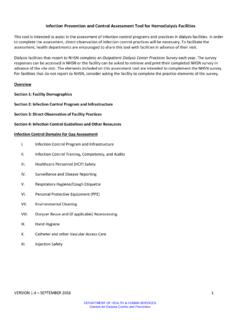Transcription of Verification and Test Methods for Access Control Policies ...
1 NIST Special Publication 800-192. Verification and Test Methods for Access Control Policies /Models Vincent C. Hu Rick Kuhn Dylan Yaga This publication is available free of charge from: C O M P U T E R S E C U R I T Y. NIST Special Publication 800-192. Verification and Test Methods for Access Control Policies /Models Vincent C. Hu Rick Kuhn Dylan Yaga Computer Security Division Information Technology Laboratory This publication is available free of charge from: June 2017. Department of Commerce Wilbur L. Ross, Jr., Secretary National Institute of Standards and Technology Kent Rochford, Acting NIST Director and Under Secretary of Commerce for Standards and Technology Authority This publication has been developed by NIST in accordance with its statutory responsibilities under the Federal Information Security Modernization Act (FISMA) of 2014, 44 3551 et seq.
2 , Public Law ( ) 113-283. NIST is responsible for developing information security standards and guidelines, including minimum requirements for federal information systems, but such standards and guidelines shall not apply to national security systems without the express approval of appropriate federal officials exercising policy authority over such systems. This guideline is consistent with the requirements of the Office of Management and Budget (OMB) Circular A-130. Nothing in this publication should be taken to contradict the standards and guidelines made mandatory and binding on federal agencies by the Secretary of Commerce under statutory authority. Nor should these guidelines be interpreted as altering or superseding the existing authorities of the Secretary of Commerce, Director of the OMB, or any other federal official.
3 This publication may be used by nongovernmental organizations on a voluntary basis and is not subject to copyright in the United States. Attribution would, however, be appreciated by NIST. National Institute of Standards and Technology Special Publication 800-192. Natl. Inst. Stand. Technol. Spec. Publ. 800-192, 68 pages (June 2017). CODEN: NSPUE2. This publication is available free of charge from: Certain commercial entities, equipment, or materials may be identified in this document in order to describe an experimental procedure or concept adequately. Such identification is not intended to imply recommendation or endorsement by NIST, nor is it intended to imply that the entities, materials, or equipment are necessarily the best available for the purpose.
4 There may be references in this publication to other publications currently under development by NIST in accordance with its assigned statutory responsibilities. The information in this publication, including concepts and methodologies, may be used by federal agencies even before the completion of such companion publications. Thus, until each publication is completed, current requirements, guidelines, and procedures, where they exist, remain operative. For planning and transition purposes, federal agencies may wish to closely follow the development of these new publications by NIST. Organizations are encouraged to review all draft publications during public comment periods and provide feedback to NIST.
5 Many NIST cybersecurity publications, other than the ones noted above, are available at Comments on this publication may be submitted to: National Institute of Standards and Technology Attn: Computer Security Division, Information Technology Laboratory 100 Bureau Drive (Mail Stop 8930) Gaithersburg, MD 20899-8930. Email: All comments are subject to release under the Freedom of Information Act (FOIA). NIST SP 800-192 Verification & TEST Methods FOR. Access Control Policies /MODELS. Reports on Computer Systems Technology The Information Technology Laboratory (ITL) at the National Institute of Standards and Technology (NIST) promotes the economy and public welfare by providing technical leadership for the Nation's measurement and standards infrastructure.
6 ITL develops tests , test Methods , reference data, proof of concept implementations, and technical analyses to advance the development and productive use of information technology. ITL's responsibilities include the development of management, administrative, technical, and physical standards and guidelines for the cost-effective security and privacy of other than national security-related information in federal information systems. The Special Publication 800-series reports on ITL's research, guidelines, and outreach efforts in information system security, and its collaborative activities with industry, government, and academic organizations. This publication is available free of charge from: Abstract Access Control systems are among the most critical of computer security components.
7 Faulty Policies , misconfigurations, or flaws in software implementations can result in serious vulnerabilities. To formally and precisely capture the security properties that Access Control should adhere to, Access Control models are usually written, bridging the gap in abstraction between Policies and mechanisms. Identifying discrepancies between policy specifications and their intended function is crucial because correct implementation and enforcement of Policies by applications is based on the premise that the policy specifications are correct. As a result, policy specifications represented by models must undergo rigorous Verification and validation through systematic Verification and testing to ensure that the policy specifications truly encapsulate the desires of the policy authors.
8 Verifying the conformance of Access Control Policies and models is a non-trivial and critical task, and one important aspect of such Verification is to formally check the inconsistency and incompleteness of the model and safety requirements of the policy, because an Access Control model and its implementation do not necessarily explicitly express the policy, which can also be implicitly embedded by mixing with direct Access constraints or other Access Control models. Keywords Access Control ; Access Control testing; Access Control Verification ; model testing; policy. Acknowledgments The authors Vincent C. Hu, Rick Kuhn and Dylan Yaga of the National Institute of Standards and Technology wish to thank their colleagues who reviewed drafts of this document.
9 The authors also gratefully acknowledge and appreciate the comments and contributions made by government agencies, private organizations, and individuals in providing direction and assistance in the development of this document. ii NIST SP 800-192 Verification & TEST Methods FOR. Access Control Policies /MODELS. Executive Summary Access Control (AC) systems Control which users or processes have Access to which resources in a system. They are among the most critical of security components. AC Policies are specified to facilitate managing and maintaining AC systems. Faulty Policies , misconfigurations, or flaws in software implementations can result in serious vulnerabilities. However, the correct implementation of AC Policies by AC mechanisms is a very challenging problem.
10 It is more common that a system's privacy and security are compromised due to the misconfiguration of AC. Policies rather than the failure of cryptographic primitives or protocols. This problem becomes increasingly severe as software systems become more complex, and are deployed to manage a large amount of sensitive information and resources that are organized into sophisticated structures. Identifying discrepancies between policy specifications and their intended function is This publication is available free of charge from: crucial because correct implementation and enforcement of Policies by applications is based on the premise that the policy specifications are correct. Thus, AC models are usually written to bridge the gap in abstraction between Policies and mechanisms to formally and precisely capture the safety requirements that AC systems should adhere to.












